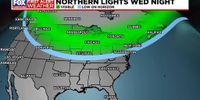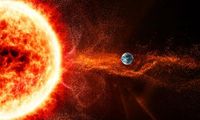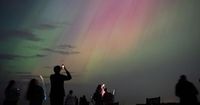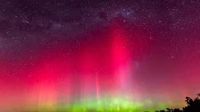Night sky watchers across the United States have a spectacular reason to look up tonight as a severe geomagnetic storm, classified as G4 by the National Oceanic and Atmospheric Administration (NOAA), sweeps past Earth. This event, driven by a fresh blast of solar particles, is expected to paint vivid auroras across the skies, potentially reaching as far south as Alabama and northern California. The Sun is currently in a particularly active phase of its 11-year solar cycle, unleashing a rapid series of coronal mass ejections (CMEs) aimed directly at Earth.
On April 16, 2025, at 5:25 PM Eastern Daylight Time, the NOAA’s Space Weather Prediction Center (SWPC) issued a G4 geomagnetic storm alert, indicating one of the highest levels of disturbance on the geomagnetic storm scale. This alert is set to remain in place through April 17 and 18, as scientists continue to monitor the storm’s progress. The current storm conditions are a result of solar wind speeds that have surged to approximately 375 miles per second, up from about 250 miles per second earlier in the week. This increase in speed suggests that conditions are ripe for a spectacular aurora display if the magnetic orientation aligns favorably.
The strength and visibility of the auroras depend largely on how Earth’s magnetic field interacts with the incoming solar material. Shawn Dahl of the SWPC explained, "The strength of the light show will depend on how Earth’s magnetic field interacts with the solar bursts." When the CME’s magnetic field points south, opposite to Earth’s field, the intensity of geomagnetic activity tends to increase sharply. Conversely, if it points north, the disturbance is usually milder.
Historically, severe geomagnetic storms have had significant impacts on both the atmosphere and technology. For instance, in 1859, a violent outburst lit Hawaiian skies and set telegraph lines ablaze. Similarly, in 1972, another storm is believed to have detonated magnetic U.S. sea mines off Vietnam. As the current storm unfolds, power companies may notice voltage fluctuations and false alarms from protective equipment. Additionally, satellites in low Earth orbit could experience increased drag, surface charging of instruments, and disruptions in attitude-control systems until the storm subsides.
As the storm progresses, mid-latitude regions, typically not accustomed to such displays, may also experience atmospheric effects. The area of greatest impact is generally poleward of about 50 degrees geomagnetic latitude, but the ripple effects can extend further south. The NOAA’s aurora alerts indicate that clear, dark skies away from city lights are essential for optimal viewing of the auroras. NASA's Kelly Korreck suggests heading to a local or national park and snapping a quick photo with a smartphone, as the sensor can reveal faint colors invisible to the naked eye. "Enjoy it," Korreck remarked. "It’s this great show … from the sun to you."
In the lead-up to this event, solar activity had been moderate. Region 4055 unleashed an M1.3 flare at 2:13 PM Eastern Daylight Time on April 15, 2025, followed by a smaller C8.1 flare at 12:39 AM on April 16. With Region 4055 rotating out of direct view, the chance of additional M-class flares has decreased from about 75 percent to 50 percent through April 18. Meanwhile, GOES-19 registered electrons above 2 million electron volts, peaking at 2,380 particles per square centimeter per second per steradian around 12:20 PM on April 15.
A shockwave from a CME that left the Sun on April 13 arrived near Earth at 12:37 PM Eastern on April 15, causing magnetometer readings to spike to 28 nanoteslas just after 2:20 PM before easing to between 12 and 18 nanoteslas. The crucial north-south component, known as Bz, dipped to -20 nanoteslas, a value capable of stirring strong geomagnetic activity. Forecast models suggest that while the current storm may weaken late on April 17, magnetospheric conditions could remain unsettled until a high-speed stream from a coronal hole passes sometime on April 18.
As excitement builds for tonight's auroras, social media is already buzzing with anticipation. Aurora chasers and casual observers alike are encouraged to keep an eye on the Space Weather Prediction Center’s aurora map or their favorite alert app, and to step outside if skies cooperate. You just might catch nature’s neon headline lighting up the night sky.
In a separate but equally concerning development, the Anderson County Sheriff’s Office has reported that a professor at Clemson University has been charged in a child pornography investigation. While this news may seem unrelated, it underscores the diverse nature of events occurring simultaneously in society.
As the geomagnetic storm unfolds, many are reminded of the delicate balance between natural phenomena and human actions. The auroras serve as a beautiful reminder of the Sun’s power and the intricate dynamics of our solar system. For those hoping to witness the dazzling displays, the next few nights may provide an unforgettable experience.
As the sun continues to unleash its energy, scientists are closely monitoring the situation, hoping to better understand the impacts of solar activity on Earth’s atmosphere and technological systems. With the current storm expected to last at least through the end of 2025, sky watchers can anticipate more sporadic auroral displays as the solar cycle progresses.
In summary, the current G4 geomagnetic storm offers a unique opportunity for night sky enthusiasts to witness a stunning natural spectacle. As auroras dance across the sky, they remind us of the beauty and unpredictability of our universe. Whether you’re an experienced observer or a curious newcomer, tonight may just be the perfect time to look up and enjoy the show.





